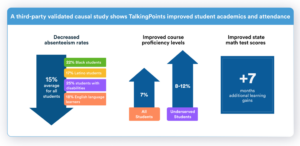Chronic absenteeism is one of the biggest challenges schools continue to grapple with—and while there’s some progress, it’s not moving fast enough. That’s why TalkingPoints recently teamed up with Attendance Works and Tulsa Public Schools for a national EdWeek webinar: Moving the Needle on Attendance: What’s Working Now
Together, we shared research, district-level strategies, and hands-on practices that are making a real difference, especially for students and families most impacted by disrupted learning.
If you missed the conversation, here’s a quick recap of what we learned—and what your district can do next.
We’re seeing progress on attendance, but not fast enough
As Hedy Chang, Founder and Executive Director of Attendance Works, reminded us during the webinar, chronic absenteeism nearly doubled post-pandemic, from 1 in 6 students to almost 1 in 3. “When you’re seeing 30% or more of your students chronically absent, it’s a system-wide issue. You need a system-wide solution.”

And that solution starts with shifting the mindset from blame to understanding. “When kids are chronically absent, it often means they’ve experienced some kind of trauma,” Hedy said. “The worst thing we can do is blame them. We need to ask, ‘What happened? How can I help?’”
That shift—toward empathy, connection, and action—is what strong attendance work is all about.
What research tells us about improving attendance
The good news? We already know what works. TalkingPoints’ Director of Research, Dr. Mallary Swartz, shared that partnerships between schools and families are key. Here are five research-proven practices that make a difference:
- Proactive, early outreach helps uncover and address barriers before attendance patterns become chronic
- Personalized, outcome-focused communication corrects misconceptions (like “missing a few days won’t matter”) and builds trust
- Behavioral nudges—simple, consistent messages—help families build routines; one example is how TalkingPoints offers a research-based attendance message series that educates and supports families year-round
- Culturally and linguistically responsive engagement ensures all families are included and supported
- Two-way communication surfaces root causes that student data systems often miss
And when schools use a tool like TalkingPoints to scale these best practices—removing barriers like language, time, and access—the impact grows. In one large, diverse district, TalkingPoints helped reduce absenteeism by 15% and contributed to academic gains equivalent to seven months of extra math learning.

Tulsa Public Schools: A real-world example of systemic success
Tulsa Public Schools has become a leading example of what’s possible when you lead with relationships, data, and whole-community collaboration. Starting in 2018 and accelerating under Superintendent Dr. Ebony Johnson, the district launched Attend to Win—a comprehensive strategy focused on improving attendance by addressing root causes and removing systemic barriers.
Their approach blends:
- Best practices from Attendance Works and the Attendance Solutions Network
- Rich data dashboards to uncover root causes (even tracking stray dogs to understand walkability!)
- Partnerships with city leaders, community groups, and every school site in the district
In Spring 2021, a study showed TalkingPoints use in Tulsa Public Schools drove a 24% drop in absenteeism, the equivalent of six more days of instruction per student each year. Gains were even stronger among students from Spanish-speaking households.
“TalkingPoints helped us reach families we just hadn’t been able to before. Texting, especially when translated and timely, became the connection point we needed.” – Grace Cáceres-Cuadros, Attendance Recovery Coordinator, Tulsa Public Schools
Then, from December 2024 to May 2025, Tulsa piloted TalkingPoints’ new Attendance Improvement Plus in four schools. Results included:
- Text-based outreach closed the gap with families who hadn’t responded to calls or flyers
- Real-time, translated messages helped parents understand absences the same day
- Unexplained, unexcused absences dropped 8%
- Families were more willing to share real reasons for missing school
“It filled the gap our other strategies left behind.” – Stephanie Gregory, Director of Family Attendance Supports, Tulsa Public Schools
What Tulsa taught us: Real-world tips you can use now
Tulsa’s pilot didn’t just lead to better attendance—it surfaced smart, practical lessons for any district looking to improve engagement.
“We were underprepared for how engaged families would be. Texting unlocked a level of communication we hadn’t seen before.” —Shionka McGlory, Family Engagement Specialist, Tulsa Public Schools
Here are a few of the top takeaways:
- Start strong during back-to-school
Make attendance part of the conversation from day one. Include visuals or take-home materials—like a stoplight chart showing what good attendance looks like—so families have a clear, consistent reminder. - Align with what’s already working
Weave attendance work into your existing Student Success Team and MTSS structures. It’s not an add-on—it’s a core part of supporting the whole child. - Plan and personalize
Preload and schedule messages around predictable events (like breaks or testing weeks), and don’t be afraid to personalize. A warm, human tone goes a long way toward building trust. - Expect—and embrace—engagement
Families will respond. Be ready. That might mean varying message content to avoid “auto-message fatigue,” sending messages earlier in the day to allow time for back-and-forth, and having a plan to support staff when responses come in after hours. - Keep the support going
Initial training is just the beginning. Build in regular check-ins and school-site follow-ups to troubleshoot, share what’s working, and keep momentum going. - Pair digital with in-person
Digital tools like texting can open doors, and in-person follow-through can deepen trust. Use tech to extend, not replace, your relationships. When families experience both timely digital outreach and face-to-face care, engagement becomes more authentic and lasting.
Looking ahead
Solving chronic absenteeism isn’t about a silver bullet; it’s about systems that put people first. Tulsa’s story proves that when you combine the right strategies with the right tools and a shared commitment to equity, you can make meaningful change.
Want to learn more about TalkingPoints’ Attendance Improvement Suite? We’d love to help.
About TalkingPoints
TalkingPoints is an education technology nonprofit with the mission to drive student success by unlocking the superpower of effective family-school partnerships. Designed for K–12 schools and districts, our award-winning, text-first platform reaches every family—automatically, in their home language, and on the devices they already use. No smartphone, Wi-Fi, downloads, or sign-ups required. With trusted two-way translation in 150+ languages and built-in best practices, TalkingPoints makes school-home communication simple, inclusive, and effective. We equip educators with the tools, insights, and support they need to build strong partnerships that boost attendance, learning, and student well-being.



